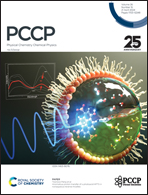Origin of the low-energy tail in the photoluminescence spectrum of CsPbBr3 nanoplatelets: a femtosecond transient absorption spectroscopic study†
Abstract
CsPbBr3 nanoplatelets (NPLs), as some of the two-dimensional lead halide perovskites, have been intensively investigated due to their outstanding photophysical and photoelectric properties. However, there remain unclear fundamental issues on their carrier kinetics and the low-energy tail in their photoluminescence (PL) spectrum. In this paper, we synthesized CsPbBr3 NPLs with five [PbBr6]4− monolayers and performed comprehensive studies by using steady-state absorption, PL, and femtosecond transient absorption (fs-TA) spectroscopic measurements. We determined both the biexciton Auger recombination time (7 ± 2 ps) and trapped exciton lifetime (110 ± 15 ps) of the five monolayer CsPbBr3 NPLs. We also investigated the origin of the low-energy tail emission in their PL spectrum. More importantly, we found that a negative ΔA feature in the energy range of 2.45–2.55 eV appears in their fs-TA spectrum at 2, 4 and 10 ps delay times, which could help them act as a laser gain medium. The low-energy tail emission in their PL spectrum overlaps well with the negative ΔA feature in the energy range of 2.45–2.55 eV in their fs-TA spectrum at 2, 4 and 10 ps delay times.



 Please wait while we load your content...
Please wait while we load your content...